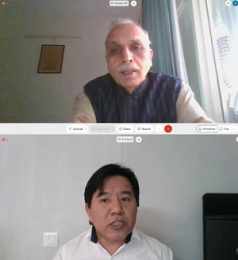On 10 November, VIF organised a discussion on ‘Elections in Myanmar and India's Way Forward". Dr Arvind Gupta, Director VIF, welcomed the participants and delivered the opening remarks followed by brief presentations by Amb Gautam Mukhopadhya, Mr Sanjay Chadha, Additional Secretary, Ministry of Commerce, Mr K Yhome, Senior Fellow, Observer Research Foundation, and Mr Sanjay Pullpaka, Senior Fellow, Delhi Policy Group.
As per the data available now, the speakers stated that the National League for Democracy (NLD) performance in the elections is more emphatic than previous 2015 elections. The NLD leader, Daw Aung San Suu Kyi seems to have held her ground because of her position at the International Court of Justice (ICJ). Though, the Myanmar Army aka Tatmadaw is not happy with the landslide victory of NLD, has raised voices to the Union Election Commission and Myanmar President about the foul play in the elections. The discussion raised concern about a threat of military coup or emergency in Myanmar post-elections. However, it will not be easy for Tamadaw to overthrow the civilian government or create conditions for a coup. However, it was also stated that due to increasing digital penetration, presence of international observers and western interventions and greater ASEAN role any voice raised by the Tatmadaw would have negative consequences.

India is perceived as a welcome partner in Myanmar. For India, people of Myanmar are the most important stakeholders. The recent joint visit by the Indian Foreign Secretary and the Army Chief gave a significant boost to India’s outreach to Myanmar. India also made a crucial decision to deliver a submarine, renamed UMS Minye Theinkhathu, to the Myanmar Navy, a move aimed at securing ties with Myanmar amid concerted efforts by China to increase its influence around India’s periphery.
In terms of border trade, India is the sixth-largest export destination and fifth-largest import destination. Over the past eight years, border trade between the two countries has declined. India exports primarily in drug formulations, which constitute around 37 per cent of total trade. Even during the time of COVID-19, Indian delegation in a recent visit handed over 3,000 vials of Remdesivir to Myanmar. Other export products include cotton yarn, auto components. India imports predominant amount of pulses from Myanmar. However, India’s border trade is less than one per cent of the total India-Myanmar trade.
India stands at 11th position in terms of total investments in Myanmar. Only 43 Indian enterprises are working in Myanmar and concentrated in sectors such as health care and oil and gas and refinery. On 04-05 October 2020, Indian Army Chief and Foreign Secretary visited Myanmar and announced a grant of USD 2 million for the construction of the border haat bridge at Byanyu/Sarsichauk in Chin State. This strategic haat will enhance economic activity between Mizoram and Myanmar. India also proposed to invest USD 6 billion to set up an oil refinery near Yangon.
Though bilateral issues remain, such as declining trade, the influx of Rohingyas, presence of Arakan Army, Western sanctions and others. India is currently lacking in big ideas, especially in the economic field. India needs to formulate a development strategy, which well coordinated with political and economic strategy. India could tap the potential that lay in the agriculture sector, the strategy which is also adopted by Thailand. Ideas to add value to the agricultural resources to create profits for both countries. The efforts should be to create an investment-led strategy and not export-led. In developing P2P relations, India has formed the Buddhist circuit; nevertheless, further work needs to be done to make it tourist-friendly for a better experience. India also needs to focus on improving air-to-air connectivity, which is poor.
India’s way forward is to secure its periphery and build a stronger bilateral economic relationship with Myanmar. The discussion explored the instruments which India could use to build strong ties with the neighbouring country in political, defence, trade and investment and people to people areas. The discussion suggested that only through easing connectivity, the trade and investment issues could be eased. The advantages of a free movement regime need to be harnessed by both the neighbours. The discussion also suggested that India must identify growth centres in North East India and invest in there to expand increasing presence economic and commercial ties with Myanmar.
It was suggested further that Myanmar should be part of the Indian Ocean Rim Association (IORA) or South Asian Association for Regional Cooperation (SAARC). Concerns were also raised about the fallout of the disintegrated approach in India and the need to start taking small incremental steps and coordinate efforts at the ground. Another concern because of the increasing role of China’s interference and support to ethnic armed groups was raised during the discussion.
In the concluding remarks, Dr Gupta reemphasized the need to continue with the “Hearts and Minds” Strategy of India, in which India should continue its support democracy and people to people relations. India should make early contacts with Daw Aung San Suu Kyi and see how the relationship will develop in the second term. To increase its immediate engagement, India must look at the agricultural sector and take effective steps for the same.










Post new comment